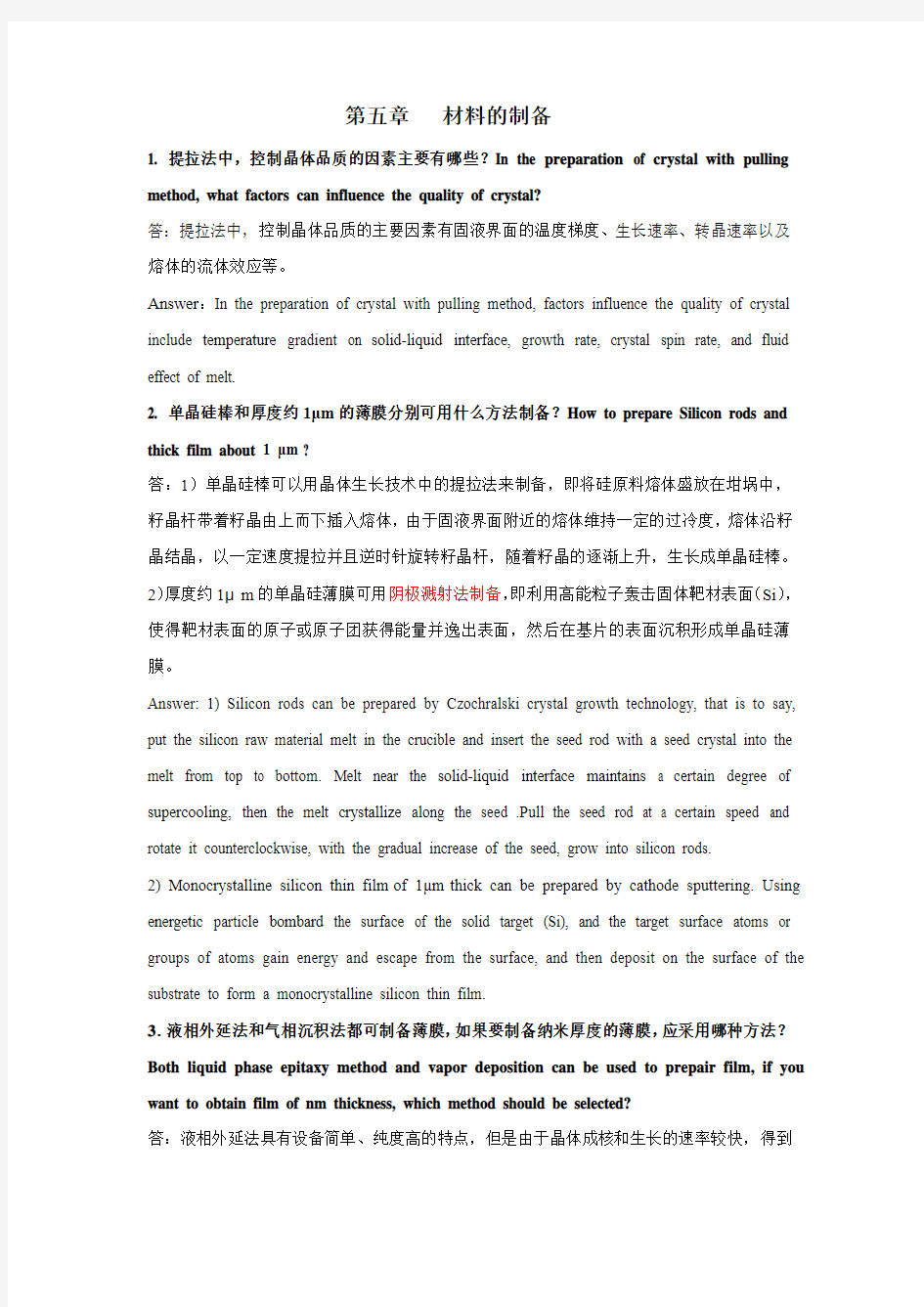南邮材料化学答案 第五章习题答案

- 1、下载文档前请自行甄别文档内容的完整性,平台不提供额外的编辑、内容补充、找答案等附加服务。
- 2、"仅部分预览"的文档,不可在线预览部分如存在完整性等问题,可反馈申请退款(可完整预览的文档不适用该条件!)。
- 3、如文档侵犯您的权益,请联系客服反馈,我们会尽快为您处理(人工客服工作时间:9:00-18:30)。
第五章材料的制备
1. 提拉法中,控制晶体品质的因素主要有哪些?In the preparation of crystal with pulling method, what factors can influence the quality of crystal?
答:提拉法中,控制晶体品质的主要因素有固液界面的温度梯度、生长速率、转晶速率以及熔体的流体效应等。
Answer:In the preparation of crystal with pulling method, factors influence the quality of crystal include temperature gradient on solid-liquid interface, growth rate, crystal spin rate, and fluid effect of melt.
2. 单晶硅棒和厚度约1μm的薄膜分别可用什么方法制备?How to prepare Silicon rods and thick film about 1 μm ?
答:1)单晶硅棒可以用晶体生长技术中的提拉法来制备,即将硅原料熔体盛放在坩埚中,籽晶杆带着籽晶由上而下插入熔体,由于固液界面附近的熔体维持一定的过冷度,熔体沿籽晶结晶,以一定速度提拉并且逆时针旋转籽晶杆,随着籽晶的逐渐上升,生长成单晶硅棒。2)厚度约1μm的单晶硅薄膜可用阴极溅射法制备,即利用高能粒子轰击固体靶材表面(Si),使得靶材表面的原子或原子团获得能量并逸出表面,然后在基片的表面沉积形成单晶硅薄膜。
Answer: 1) Silicon rods can be prepared by Czochralski crystal growth technology, that is to say, put the silicon raw material melt in the crucible and insert the seed rod with a seed crystal into the melt from top to bottom. Melt near the solid-liquid interface maintains a certain degree of supercooling, then the melt crystallize along the seed .Pull the seed rod at a certain speed and rotate it counterclockwise, with the gradual increase of the seed, grow into silicon rods.
2) Monocrystalline silicon thin film of 1μm thick can be prepared by cathode sputtering. Using energetic particle bombard the surface of the solid target (Si), and the target surface atoms or groups of atoms gain energy and escape from the surface, and then deposit on the surface of the substrate to form a monocrystalline silicon thin film.
3.液相外延法和气相沉积法都可制备薄膜,如果要制备纳米厚度的薄膜,应采用哪种方法?Both liquid phase epitaxy method and vapor deposition can be used to prepair film, if you want to obtain film of nm thickness, which method should be selected?
答:液相外延法具有设备简单、纯度高的特点,但是由于晶体成核和生长的速率较快,得到
的膜较厚,很难得到纳米厚度的薄膜。物理气相沉积可通过调控蒸镀源与靶之间的距离来调控膜沉积的速率,化学气相沉积可通过体系的温度、压力等因素来调控膜沉积的速率。因此,如果要制备纳米厚度的薄膜,应采用气相沉积法比较好。
Answer: Liquid phase epitaxy method is simple, and the purity of film is high, however, because the rate of nucleate formation and crystal growth is fast, it is difficult to get the membrane of nm thickness. For Physical vapor deposition, we can control the rate of film deposition through regulating the distance between the source and target. For chemical vapor deposition, we can control the film deposition rate by controlling temperature and pressure. So if you want to prepare film of nanometer thickness, vapor deposition should be selected.
4. CVD法沉积SiO2可通过哪些反应实现?写出相关化学方程式。Which reactions can be used to deposite SiO2 with CVD? Write the relevant chemical equation.
答:CVD法沉积SiO2可通过以下几种反应来实现。
1)烷氧化物的热分解:Si (OC2H5)4 →SiO2 + C2H4 + H2O
2)硅化合物的氧化反应:SiCl4 (g) + O2 (g) →SiO2 (s) + 2Cl 2 (g)
SiH4 (g) + O2 (g) →SiO2 (s) + 2H 2 (g)
SiCl4 (g) + 2CO2 + 2H 2(g) →SiO2 (s) + 4HCl (g) + 2CO (g)
3)硅化合物的水解反应:SiCl4 (g) + 2H2O (g) →SiO2 (s) + 4HCl (g)
Answer: CVD deposition of SiO2 can be achieved through the following reaction:
1) The alkoxide thermal decomposition: Si (OC2H5)4 → SiO2 + C2H4 + H2O
2) Oxidation of silicon compounds: SiCl4 (g) + O2(g) → SiO2 (s) + 2Cl 2 (g)
SiH4 (g) + O2(g) → SiO2 (s) + 2H 2 (g)
SiCl4 (g) + 2CO2 + 2H 2(g) → SiO2 (s) + 4HCl (g) + 2CO (g)
3) Hydrolysis of silicon compounds: SiCl4 (g) + 2H2O (g) → SiO2 (s) + 4HCl (g)
5. 用什么方法可以对Cu 和Cu2O进行分离?写出相关化学方程式。What method can be used for separation of Cu and Cu2O? Write the relevant chemical equation
答:对Cu 和Cu2O进行分离,可以采用化学气相输运技术,以HCl 作为输运气体。过程中发生如下反应:
